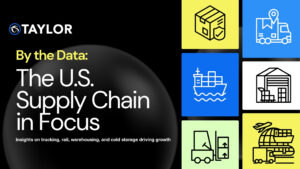
Across the global supply chain, every link is advancing. Trucking, rail, warehousing, and cold storage are all being reshaped by data, automation, and new expectations for speed, reliability, and sustainability.
Taylor continues to focus on total supply chain solutions that evolve with the industry, combining technology and collaboration to create a seamless experience for shippers.
Trucking Drives the Short-Haul Economy
The local freight trucking industry now generates $99.1 billion in annual revenue, growing 6.1% between 2020 and 2025 and projected to rise another 1.3% through 2030. While profit margins hover around 8.6%, digitalization and route optimization continue to improve efficiency and reduce costs. Local freight employment stands near 583,000 workers, supported by growth in same-day and e-commerce delivery, which has increased revenue for some carriers by over 40%.
Companies are focusing on cleaner fleets and operational technology to adapt to new emission standards and rising equipment costs. With consumer spending and industrial production on the rise, local freight is positioned as the most flexible link between regional hubs and final destinations.
Rail Strengthens Long-Haul Efficienc
Rail remains one of the most efficient ways to move bulk and intermodal freight. The U.S. rail industry produces $103 billion in revenue, supported by 120,000 employees across 624 companies. Intermodal freight accounts for nearly half of all revenue at $50.3 billion, followed closely by bulk commodities at $48.9 billion.
Rail companies are investing in modernization, including electric and hybrid locomotives, digital signaling, and network expansion. These improvements, combined with intermodal growth, are expected to sustain 1% annual revenue increases and maintain a 28.8% industry profit margin. As industrial production and oil and gas output rise, rail continues to complement trucking by moving long-haul freight efficiently while supporting sustainability goals
Warehousing Becomes the Central Hub
The general warehousing and storage sector remains the backbone of U.S. distribution, bridging manufacturers and retailers with efficient inventory management. The industry’s capacity is growing in key regions like the Southeast and Great Lakes, with over 6,000 facilities in California alone and strong expansion across Texas, New Jersey, and Pennsylvania.
Labor remains the largest cost at 56.2% of revenue, driving a shift toward automation and data-driven operations to offset wage pressures. Profit margins currently average 3.7%, with energy-efficient building incentives and renewable energy adoption helping operators cut costs and meet ESG standards. Warehousing is evolving into a data-driven service center that manages fulfillment, returns, and inventory with real-time visibility .
Cold Storage Expands Capacity and Technology
The refrigerated storage industry is growing at 3.2% annually, reaching $8.9 billion in revenue, with employment up 6.3% since 2020. Operators employ nearly 70,000 workers across 790 businesses, and efficiency gains from automation and advanced temperature monitoring continue to improve profit margins, currently averaging 7.5%.
Cloud-based inventory systems and robotics have reduced manual labor needs while enhancing precision and compliance. With demand rising for fresh foods, pharmaceuticals, and global trade storage, cold storage is now central to ensuring product integrity throughout the supply chain.
The Connected Chain
Every link, from trucking to rail, warehousing, and cold storage, is advancing through the use of data and innovation. The success of the total supply chain depends on collaboration and visibility, where technology connects each step from origin to destination.
Taylor continues to lead with solutions that integrate transportation and storage, building supply chains that are more connected, efficient, and ready for what’s next.
Source: IBISWorld Industry Reports on Local Freight Trucking, Rail Transportation, General Warehousing and Storage, and Refrigerated Storage in the U.S.










